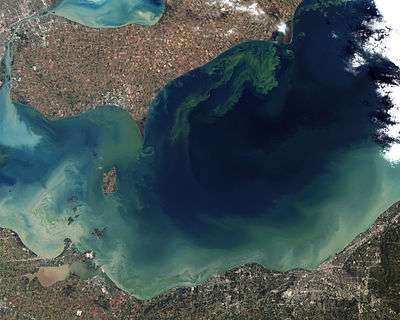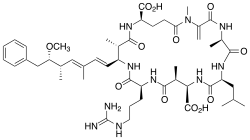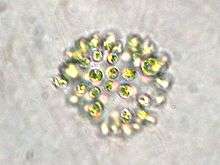Microcystin
Microcystins — or cyanoginosins — are a class of toxins produced by certain freshwater blue-green algae. Over 50 different microcystins have been discovered so far, of which microcystin-LR is the most common. Chemically they are cyclic heptapeptides produced through nonribosomal peptide synthases.

Cyanobacteria can produce microcystins in large quantities during algal blooms which then pose a major threat to drinking and irrigation water supplies, and the environment at large.[3][4]
Characteristics

Microcystins — or cyanoginosins — are a class of toxins[5] produced by certain freshwater cyanobacteria; primarily Microcystis aeruginosa but also other Microcystis, as well as members of the Planktothrix, Anabaena, Oscillatoria and Nostoc genera. Over 50 different microcystins have been discovered so far, of which microcystin-LR is the most common. Chemically they are cyclic heptapeptides produced through nonribosomal peptide synthases.[6]
Microcystin-LR is the most toxic form of over 80 known toxic variants, and is also the most studied by chemists, pharmacologists, biologists, and ecologists. Microcystin-containing 'blooms' are a problem worldwide, including China, Brazil, Australia, South Africa,[7][8][9][10][11][12][13][14] the United States and much of Europe. Hartebeespoort Dam in South Africa is one of the most contaminated sites in Africa, and possibly in the world.
Microcystins contain several uncommon non-proteinogenic amino acids such as dehydroalanine derivatives and the uncommon β-amino acid ADDA. Microcystins covalently bond to and inhibit protein phosphatases PP1 and PP2A and can thus cause pansteatitis.[15]
Formation

The microcystin-producing Microcystis is a genus of freshwater cyanobacteria and thrives in warm water conditions, especially in stagnant waters.[4] The EPA predicted in 2013 that climate change and changing environmental conditions may lead to harmful algae growth and may negatively impact human health.[16] Algal growth is also encouraged through the process of eutrophication (oversupply of nutrients).[4] In particular, dissolved reactive phosphorus promotes algal growth.[17]
Exposure pathways
Humans are exposed by swallowing, skin contact with or inhaling contaminated water.[18] Microcystins are chemically stable over a wide range of temperature and pH, possibly as a result of their cyclic structure.[19] Microcystin-producing bacteria algal blooms can overwhelm the filter capacities of water treatment plants. Some evidence shows the toxin can be transported by irrigation into the food chain.[20][21]
Lake Erie blooms
In 2011, a record outbreak of blooming microcystis occurred in Lake Erie, in part related to the wettest spring on record, and expanded lake bottom dead zones, reduced fish populations, fouled beaches, and damaged the local tourism industry, which generates more than $10 billion in revenue annually.[1]
In August 2014, the City of Toledo, Ohio detected unsafe levels of microcystin in its water supply due to harmful algal blooms in Lake Erie, the shallowest of the Great Lakes. The city issued an advisory to approximately 500,000 people that the water was not safe for drinking or cooking.[22][23] An Ohio state task force found that Lake Erie received more phosphorus than any other Great Lake, both from crop land, due to the farming practices, and from urban water-treatment centres.[17]
San Francisco Bay Area
In 2016, microcystin had been found in San Francisco Bay Area shellfish in seawater, apparently from freshwater runoff, exacerbated by drought.[24]
Iowa
In 2018, the Iowa Department of Natural Resources found microcystins at levels of .3 µg/L, or micrograms per liter, which is equivalent to .3 parts per billion in the raw water supplies of 15 out of 26 public water systems tested.[25]
Human health effects upon exposure
Microcystins cannot be broken down by standard proteases like pepsin, trypsin, collagenase, and chymotrypsin due to their cyclic chemical nature.[19] They are hepatotoxic, i.e., able to cause serious damage to the liver. Once ingested, microcystin travels to the liver via the bile acid transport system, where most is stored, though some remains in the blood stream and may contaminate tissue.[26][27] Acute health effects of Microcystin-LR are abdominal pain, vomiting and nausea, diarrhea, headache, blistering around the mouth, and after inhalation sore throat, dry cough, and pneumonia.[28]
There appears to be inadequate information to assess the carcinogenic potential of microcystins by applying EPA Guidelines for Carcinogen Risk Assessment. A few studies suggest a relationship may exist between liver and colorectral cancers and the occurrence of cyanobacteria in drinking water in China.[29][30][31][32][33][34] Evidence is, however, limited due to limited ability to accurately assess and measure exposure.
Regulation
In the US, the EPA issued a health advisory in 2015.[35] A ten day Health Advisory was calculated for different ages which is considered protective of non-carcinogenic adverse health effects over a ten-day exposure to microcystins in drinking water: 0.3 μg/L for bottle-fed infants and young children of pre-school age and 1.6 μg/L for children of school age through adults.[35]:28–29
See also
References
- Michael Wines (March 14, 2013). "Spring Rain, Then Foul Algae in Ailing Lake Erie". The New York Times.
- Joanna M. Foster (November 20, 2013). "Lake Erie is Dying Again, and Warmer Waters and Wetter Weather are to Blame". ClimateProgress. Archived from the original on August 3, 2014. Retrieved August 3, 2014.
- Paerl HW, Huisman J (February 2009). "Climate change: a catalyst for global expansion of harmful cyanobacterial blooms". Environmental Microbiology Reports. 1 (1): 27–37. doi:10.1111/j.1758-2229.2008.00004.x. PMID 23765717.
- "Increasing toxicity of algal blooms tied to nutrient enrichment and climate change". Oregon State University. October 24, 2013.
- Dawson, R.M (1998). "the toxicology of microcystins". Toxicon. 36 (7): 953–962. doi:10.1016/S0041-0101(97)00102-5. PMID 9690788.
- Ramsy Agha, Samuel Cirés, Lars Wörmer and Antonio Quesada (2013). "Limited Stability of Microcystins in Oligopeptide Compositions of Microcystis aeruginosa (Cyanobacteria): Implications in the Definition of Chemotypes". Toxins. 5 (6): 1089–1104. doi:10.3390/toxins5061089. PMC 3717771. PMID 23744054.CS1 maint: uses authors parameter (link)
- Bradshaw D, Groenewald P, Laubscher R, Nannan N, Nojilana B, Norman B, Pieterse D, Schneider M (2003). Initial Burden of Disease Estimates for South Africa, 2000 (PDF). Cape Town: South African Medical Research Council. ISBN 978-1-919809-64-9. Archived from the original (PDF) on 2016-03-03. Retrieved 2014-08-04.
- Fatoki, O.S., Muyima, N.Y.O. & Lujiza, N. 2001. Situation analysis of water quality in the Umtata River Catchment. Water SA, (27) Pp 467-474.
- Oberholster PJ, Botha AM, Cloete TE (2005). "An overview of toxic freshwater cyanobacteria in South Africa with special reference to risk, impact, and detection by molecular marker tools". Biokemistri. 17 (2): 57–71. doi:10.4314/biokem.v17i2.32590.
- Oberholster PJ, Botha AM (2007). "Use of PCR based technologies for risk assessment of a winter cyanobacterial bloom in Lake Midmar, South Africa". African Journal of Biotechnology. 6 (15): 14–21.
- Oberholster, P. 2008. Parliamentary Briefing Paper on Cyanobacteria in Water Resources of South Africa. Annexure "A" of CSIR Report No. CSIR/NRE/WR/IR/2008/0079/C. Pretoria. Council for Scientific and Industrial Research (CSIR).
- Oberholster, P.J.; Cloete, T.E.; van Ginkel, C.; Botha, A-M.; Ashton, P.J. (2008). "The use of remote sensing and molecular markers as early warning indicators of the development of cyanobacterial hyperscum crust and microcystin-producing genotypes in the hypertrophic Lake Hartebeespoort, South Africa" (PDF). Pretoria: Council for Scientific and Industrial Research. Archived from the original (PDF) on 2014-08-11.
- Oberholster, P.J.; Ashton, P.J. (2008). "State of the Nation Report: An Overview of the Current Status of Water Quality and Eutrophication in South African Rivers and Reservoirs" (PDF). Pretoria: Council for Scientific and Industrial Research. Archived from the original (PDF) on 2014-08-08.
- Turton, A.R. 2015. Water Pollution and South Africa’s Poor. Johannesburg: South African Institute of Race Relations. http://irr.org.za/reports-and-publications/occasional-reports/files/water-pollution-and-south-africas-poor Archived 2017-03-12 at the Wayback Machine
- Barnett A. Rattner, Glenn H. Olsen, Peter C. McGowan, Betty K. Ackerson, and Moira A. McKernan. "Harmful Algal Blooms and Bird Die-offs in Chesapeake Bay: A Potential Link?". Patuxent Wildlife Research Center.CS1 maint: multiple names: authors list (link)
- "Impacts of Climate Change on the Occurrence of Harmful Algal Blooms" (PDF). EPA. 2013.
- Suzanne Goldenberg (August 3, 2014). "Farming practices and climate change at root of Toledo water pollution". The Guardian.
- How are humans exposed to cyanobacteria and cyanotoxins? EPA, retrieved 12 Nov 2018
- Somdee, Theerasak; Thunders, Michelle; Ruck, John; Lys, Isabelle; Allison, Margaret; Page, Rachel (2013). "Degradation of [Dha7]MC-LR by a Microcystin Degrading Bacterium Isolated from Lake Rotoiti, New Zealand". ISRN Microbiology. 2013: 1–8. doi:10.1155/2013/596429. PMC 3712209. PMID 23936728.
- Codd GA, Metcalf JS, Beattie KA (August 1999). "Retention of Microcystis aeruginosa and microcystin by salad lettuce (Lactuca sativa) after spray irrigation with water containing cyanobacteria". Toxicon. 37 (8): 1181–5. doi:10.1016/S0041-0101(98)00244-X. PMID 10400301.
- Abe, Toshihiko; Lawson, Tracy; Weyers, Jonathan D. B.; Codd, Geoffrey A. (August 1996). "Microcystin-LR Inhibits Photosynthesis of Phaseolus vulgaris Primary Leaves: Implications for Current Spray Irrigation Practice". New Phytologist. 133 (4): 651–8. doi:10.1111/j.1469-8137.1996.tb01934.x. JSTOR 2558683.
- "Algal bloom leaves 500,000 without drinking water in northeast Ohio". Reuters. August 2, 2014.
- Rick Jervis, USA TODAY (August 2, 2014). "Toxins contaminate drinking water in northwest Ohio".
- John Raphael BEWARE: High Levels of Freshwater Toxin Found in Shellfish from San Francisco Bay Oct 28, 2016. Nature World News
- Kate Payne Toxic Bacteria Blooms Impacting Water Systems Across Iowa, DNR Survey Shows. November 1, 2018. National Public Radio
- Falconer, Ian R. (1998). "Algal Toxins and Human Health". In Hrubec, Jiři (ed.). Quality and Treatment of Drinking Water II. The Handbook of Environmental Chemistry. 5 / 5C. pp. 53–82. doi:10.1007/978-3-540-68089-5_4. ISBN 978-3-662-14774-0.
- Falconer, I.R. 2005. Cyanobacterial Toxins of Drinking Water Supplies: Cylindrospermopsins and Microcystins. Florida: CRC Press. 279 pages.
- What health risks do humans face as a result of exposure to cyanotoxins? EPA, retrieved 12 Nov 2018
- Humpage AR, Hardy SJ, Moore EJ, Froscio SM, Falconer IR (October 2000). "Microcystins (cyanobacterial toxins) in drinking water enhance the growth of aberrant crypt foci in the mouse colon". Journal of Toxicology and Environmental Health, Part A. 61 (3): 155–65. doi:10.1080/00984100050131305. PMID 11036504.
- Ito E, Kondo F, Terao K, Harada K (September 1997). "Neoplastic nodular formation in mouse liver induced by repeated intraperitoneal injections of microcystin-LR". Toxicon. 35 (9): 1453–7. doi:10.1016/S0041-0101(97)00026-3. PMID 9403968.
- Nishiwaki-Matsushima R, Nishiwaki S, Ohta T, et al. (September 1991). "Structure-function relationships of microcystins, liver tumor promoters, in interaction with protein phosphatase". Japanese Journal of Cancer Research. 82 (9): 993–6. doi:10.1111/j.1349-7006.1991.tb01933.x. PMC 5918597. PMID 1657848.
- Ueno Y, Nagata S, Tsutsumi T, et al. (June 1996). "Detection of microcystins, a blue-green algal hepatotoxin, in drinking water sampled in Haimen and Fusui, endemic areas of primary liver cancer in China, by highly sensitive immunoassay". Carcinogenesis. 17 (6): 1317–21. doi:10.1093/carcin/17.6.1317. PMID 8681449.
- Yu S-Z (1989). "Drinking water and primary liver cancer". In Z.Y. Tang; M.C. Wu; S.S. Xia (eds.). Primary Liver Cancer. New York: China Academic Publishers. pp. 30–7. ISBN 978-0-387-50228-1.
- Zhou L, Yu H, Chen K (June 2002). "Relationship between microcystin in drinking water and colorectal cancer". Biomedical and Environmental Sciences. 15 (2): 166–71. PMID 12244757.
- Drinking Water Health Advisory for the Cyanobacterial Microcystin Toxins U.S. Environmental Protection Agency Office of Water, EPA Document Number: 820R15100, 75pp, 15 June 2015
Further reading
- National Center for Environmental Assessment. Toxicological Reviews of Cyanobacterial Toxins: Microcystins LR, RR, YR, and LA (NCEA-C-1765)
External links
- Harmful Algal Blooms (EPA), n.d. retrieved 12 Nov 2018
- Blue-Green Algae (Cyanobacteria) and their Toxins (Health Canada)
- Toxic cyanobacteria in water: A guide to their public health consequences, monitoring, and management (WHO)
- Cyanobacteria and Cyanotoxins: Information for Drinking Water Systems (EPA)
- Cyanobacteria Are Far From Just Toledo’s Problem By Carl Zimmer, Aug. 7, 2014(The New York Times)